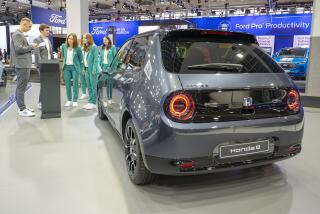Honda Pressing Ahead With Indy Car Plans : Automotive: Santa Clarita unit will supply engines for the company. Veteran driver Bobby Rahal will use the auto giant’s power plants.
- Share via
SANTA CLARITA — Although Honda Motor Company’s sales and profits have nose-dived, the Japanese car manufacturer is still going through with plans to compete in Indy car racing next year.
Honda will be the first Japanese auto maker to develop racing engines used to power Indy cars. For years the field was dominated by Ford and Chevrolet, until Chevy announced recently that it was dropping out of Indy car racing.
The newly established Honda Performance Development Inc. in Santa Clarita will supply a new V-8, turbocharged engine when the PPG Indy Car World Series 1994 season begins in March.
Company executives are keeping details of the engine a closely guarded secret, except to say they are still testing a prototype. They are being equally secretive about the Santa Clarita facility, where the Japanese-built engine will be maintained and tested. The new subsidiary’s phone number is unlisted and that suits Honda officials just fine.
Mike Spencer, spokesman for American Honda Motor Co. in Torrance, said the Santa Clarita facility opened April 1 and employs about 12 workers and technicians. When the Indy car racing season begins in March, the number of employees is expected to triple, Spencer said.
Honda will team with veteran race driver Bobby Rahal, co-owner of Rahal/Hogan Racing Inc., who will supply the Indy cars. Rahal, who won the 1986 Indianapolis 500 and three Indy car championships, was formerly associated with Chevy. He said his team will race two Honda-powered cars built around a British-made Lola chassis.
“We’ve been testing the engine and so far we like what we see. It’s our intention to win the (Indy Car World) series, and there’s no question Honda can help us do that,” said Rahal, who also owns a Honda dealership in Pennsylvania.
Honda enjoyed remarkable success in Formula One racing, winning the driving championship in six of the 10 years the company competed, before dropping out last season. But Formula One racing is more expensive than Indy car racing, and the circuit offers fewer marketing opportunities for auto makers.
John Chuhran, director of media relations for Indy car, said it costs about $12 million for a team to field two competitive cars for the Indy car season. By comparison, Chuhran said racing officials estimated that Honda spent “in excess of $50 million in engine programs for Formula One racing” last year. Honda officials have said they opted for the Indy car program after sales plummeted 17% to 794,000 in 1992. And Honda is not faring much better in Japan, where in the first seven months of the year sales fell 12%.
Company officials are now counting on the redesigned 1994 Accord to improve the company’s financial picture. “If this car fails, we don’t survive,” Honda Motor Co. President Nobuhiko Kawamoto said in a recent Business Week interview.
Last month, the auto maker announced it will cut costs by producing all of the Accord and Civic models it sells in North America at its plants in Ohio. Executives said it will be cheaper to build the cars in the United States because the yen has been gaining in value against the dollar, making Japanese exports more expensive.
Although Indy car racing is arguably the most popular spectator sport in the world, there is also a practical side to it that keeps car companies interested in the sport, Chuhran said. The competitive nature of Indy car racing, where cars reach 215 m.p.h., makes it impossible for participants to use standard engines in cars. Indy car engines are specifically designed for racing and few production parts are used in their manufacture.
Instead, auto makers use the experience to develop new technologies that are eventually used in passenger cars. For example, the rear view mirror, which has been standard equipment on U.S. cars for about 75 years, made its first appearance at the 1911 Indianapolis 500 race.
Most cars sold in the United States today use a computer to measure the fuel flow to the engine, in order to assure optimum mileage and horsepower. This electronic engine system was developed by Chevy and first used in 1988 in Indy car racing.
“Indy car racing is not just a spectator sport. It’s also used to develop new technologies that are eventually used in the cars that you and I drive,” Chuhran said.
Indy car racing will “give valuable experience to our U.S. engineers and technicians,” said Honda spokesman Spencer.
More to Read
Inside the business of entertainment
The Wide Shot brings you news, analysis and insights on everything from streaming wars to production — and what it all means for the future.
You may occasionally receive promotional content from the Los Angeles Times.










